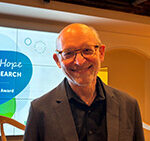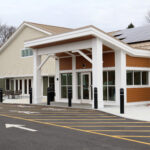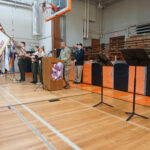In 1850, Wayland opened the doors to the first free public library in Massachusetts. More than 175 years later, the Wayland Free Public Library remains a cornerstone of the community. Still, as it adapts to modern needs, questions remain about how a historic institution can keep pace in a changing world — and whether the town that pioneered public libraries is still leading the way.
A town of firsts
In 1848, Rev. Dr. Francis Wayland, a town resident and the president of Brown University, decided that he would donate $500 to establish a free public library in the town that bore his name, but only on the condition that his fellow residents matched the donation.
The news reached the community, and for the next month, the money trickled in. Wayland residents contributed, many in amounts as little as a dime to a few dollars, until at a town meeting that March, the town accepted $1,000 for the creation of a library.
In August 1850, two renovated rooms in the white-columned Cochituate Road “Town House” — more recently known as Collins Market — opened up to the reading public.
Kay Gardner-Westcott, curator at the Wayland Historical Society, said that she has defended Wayland’s status as the state’s first public library against historians from Boston, who also claim the title. “I think if you press Boston, they’ll admit it is Wayland,” she said. “We have the records; we have the minutes and everything here that shows that we were the first.”
But it wasn’t just Wayland’s “first” status that cemented its place in library history. Following some debate within the town about the legality of using tax revenue to fund the library, Wayland’s state representative, Rev. John Wight, introduced legislation in the state assembly in 1851 that would make it expressly legal to use tax revenue to fund public libraries. He hoped his efforts would clear legal hurdles that required towns to get approval from the state’s general court before establishing a public library. The governor signed Wight’s law in May 1851. In the first decade of the law, four of Wayland’s six bordering towns started libraries, all benefitting from the streamlined process set forth by a Wayland representative.
The library expanded into a Cochituate branch location to serve the more populous area of South Wayland starting in 1874. At first, a horse and buggy carried books over the 12 miles between the main branch and the “Cochituate Reading Room” located at a former storefront on Main Street. It moved to the Cochituate Fire Station in 1953. The Cochituate branch officially closed in 1989 due to funding constraints. Gardner-Wescott, who formerly worked at the Cochituate branch, said she misses it.
“It was a wonderful little library, and it was very well-used,” she said.
Disaster struck the library in March 2010 when a series of powerful storms flooded the lower parking lot, causing water to seep up through the library’s floors. It left two inches of rainwater on the first floor. The library staff prepared for the worst by transferring all the books on the lower shelves to higher ones. However, the books still had to be removed, as they would otherwise be destroyed by mildew.
Library workers and community members sprang into action, forming a brigade that started from the Children’s Room on the first floor, proceeding up the staff stairs and into the North Wing, where they passed books by hand up the stairs to safety. Only four books were lost, dropped into the water in the bustle of the rescue.
A library transformed
Since the first collection of 700 volumes in the 1850s at Town Hall Annex, Wayland’s Library has grown to comprise more than 76,000 books, all still housed in the Roman Revival building off Concord Road. Library Director Christopher Lindquist said he’s honored to walk in the footsteps of generations dedicated to the mission of free education.
“We’re standing on the shoulders of people who, years ago, wanted to create something for the common good, for the community,” he said. “I’m just so amazed that here we are in our 176th year, and still doing what they started back in 1848.”
Andrew Loof, bibliographic services and local history associate at the library, said he’s proud to work at a library with such a rich history, specifically one that hired one of the first female librarians in America, Sarah Heard, in 1885.
One of the most significant changes in Wayland Library’s history is the increased openness of its resources, according to Lindquist. In the first few decades of the library’s existence, books were stored in closed stacks that could only be accessed by librarians. Today, every resource at the Wayland Library is available to the public, including both physical volumes from the library and its network, as well as a wealth of digital resources.
“Back then, librarians were considered gatekeepers, but we are more facilitators, navigators — you know, people that will preserve, but we preserve for the common good,” Lindquist said. “We want people to be able to access that information.”
Becoming a community space
With the greater sharing of resources, Lindquist said the building has transformed from a home for books to a multipurpose community center. Today, the library lends everything from a power washer to a 3D printer, as well as hosting lectures and community events.
“It’s much more of that third space for neighbors to meet, go to a lecture or attend a children’s program, or what have you,” Lindquist said. “It’s still a place where we have books, but more and more, it’s a community space.”
However, as much as the Wayland Free Public Library has evolved into a 21st-century institution, Lindquist said it also struggles with some elements that are stuck in the past. Many of these challenges stem from the constraints of a 1900 building that was remodeled in 1987. Its bold brick exterior boasts imposing columns, a Donatello-inspired frieze but also a wheelchair-inaccessible mezzanine, narrow doorways, and limited parking.
It’s also built on a marshy hill, which has perennially caused anxiety for stakeholders in the library and partially contributed to the library’s damage in the 2010 flood.
Even before the building’s construction at the turn of the 20th century, planners recognized the location’s problems, but their hands were tied. In 1897, amid plans for a new library, a wealthy Wayland resident, Warren G. Roby, donated a half-acre of land and $28,000 to the town to be used for building a new library — but only on the condition that it be built on his exact plot of land.
“The committee that was in charge of building the library hated the site so much that they started looking for legal options to build elsewhere,” Loof said. “This plot of land has been challenging [and] contentious from the outset.”
In 2018, Wayland residents had a chance to address some of these issues. A proposal to construct a new library next to Wayland Middle School was submitted to Town Meeting. The design envisioned a space two and a half times the library’s current size, with full wheelchair access and in closer proximity to Wayland’s schools. But the initiative failed in a 760-479 vote, falling short of the required two-thirds majority.
Lindquist was understandably disappointed that a brand-new library didn’t come to fruition. “That was painful,” he said.
What’s next
With new construction off the table, Lindquist said he and his team found smaller ways to improve their space, such as making the bathrooms wheelchair accessible, adding a path to the Children’s Room, and updating the elevator.
“We want to reconfigure the space,” Lindquist said. “That’s kind of our next focus. Probably in the coming year, we’re going to be engaging a space planning consultant that helps us look at the current footprint and see how we can reconfigure it.”
Lindquist said he’s also looking to offer services outside the library walls through initiatives like curbside book drop-off for patrons with disabilities, programs for children at Hannah Williams Park, and events for seniors at the Council on Aging.
“There are always opportunities to do outreach so we don’t have to be physically here,” Lindquist said. “We can also bring the library out to the community.”
As much as the library staff focuses on improvement, Gardner-Westcott said she worries that Wayland isn’t honoring the rich legacy of its library with facilities that match. “Wayland was the first, and they’re allowing it to, not die, but perhaps wither a little because they’re not giving it the opportunity that it needs,” she said.












